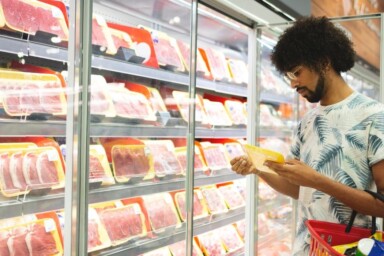When we first went into lockdown last year, I was fortunate enough to retreat to my parents’ leafy garden in the countryside. I spent those hot spring mornings with my bare feet curled along the border of vegetable beds, listening to the thrushes as I started my daily watering ritual. So many of us turned to the soil when the pandemic struck. The momentary pause of capitalism’s ceaseless rush gave us space to re-evaluate. With limited access to green spaces, our collective awareness realised the importance of our connection to the land and to the food we eat. It also revealed the deep disparities of our systems: how was it that I could quietly tend a vegetable garden when others were trapped in tiny flats, trying to teach their kids on screens in the sweltering heat?
As the crisis deepened and panic buying led to shortages in essential food items, the fragility of our convoluted food supply chains became apparent. There are three core problems that characterise our UK food system: environmental degradation, poor health and increasing food insecurity. These market failures are the inevitable consequence of a supply system that priorities profit accumulation over the equal distribution of benefits across society.
In the UK alone, over 8 million people don’t get enough to eat. The pandemic saw food insecurity experiences rise to 16% of the population and revealed the inordinate impact of food poverty on certain groups, including Black, Asian and Minority Ethnic (BAME) communities and disabled people. There is also a direct correlation between food insecurity and unhealthy diets: fresh, nutrient-rich produce is three times the price of processed foods in the UK. This means that a significant portion of society have diets that are high in processed foods and low in fruit and veg, which puts them at risk of severe ill health. In May 2020, one in three people who died in English hospitals with coronavirus also had diabetes.
Long supply chains also create distance between the consumer and our food. This disconnection means we lose a fundamental understanding about our food and where it comes from, which impacts our capacity to make conscious choices about a vital part of our lives.
Because the concentration of buying power sits with the supermarkets, farmers are faced with abrupt changes in sourcing policies, which exposes them to economic risk and limits their autonomy. With ever decreasing farm gate prices, producers are caught in a loop of using harmful farming practices to keep production costs down. Methods such as monocultures and agricultural pesticides are depleting our soils and impacting natural pest control. This inevitably affects the resilience of our food system.
Not only do our complex global supply chains rely heavily on production systems that produce high emissions, they are also easily impacted by outside forces, particularly changes in oil prices and shifting weather patterns. This means their long-term economic viability is fragile.
Local small-scale producers are better placed to acclimatise quickly to unexpected shocks: in the first two weeks of lockdown last spring, veg box sales rose from 68,000 to 144,000. The demand for local food increased over the pandemic, with weekly veg box schemes doubling their orders. The call for projects that focus on alleviating food poverty also rose: 10% of weekly veg box schemes have now created systems that support people on low incomes.
Local food upholds the principles of agroecology because it recognises both the environmental and social value of our food systems. Agroecological systems elevate the importance of our interdependent relationship with nature and reveal how this connection can enhance conservation efforts and address food insecurity. Rooted in this whole systems approach, local food models can address the complex interrelated issues of our current food supply system.
***
Local food businesses have the benefit of a variety of routes to market, including box schemes, local retail, restaurants and farmers’ markets. This ensures that if one of these markets fails, the economic risk for farmers is more evenly distributed. Local food systems sell produce along a much shorter supply chain, which means the price of the food is more fairly distributed between all those involved. Producers, therefore, receive a better farm gate price. As a result, farmers can afford the higher production costs of organic farming methods, which in turn improves soil health and supports biodiversity. As we face the impacts of a changing climate and degraded farmland, these practices are central to building the resilience of our food system. They also improve the earth’s long-term capacity for production, which ultimately means ecological resilience will become synonymous with economic resilience.
Local food systems have the potential to create thriving communities, in both urban and rural areas. The New Economics Foundation found that every £10 spent in a local food business is worth almost £25 to the local economy. Research from the University of Gloucestershire revealed that for every £1 invested in local food, between £6 and £8 are returned to society in the form of social and economic benefits, including health, wellbeing, training and skills. Because local food production is synonymous with agroecological farming methods, there are significant health benefits associated with local produce including increased levels of antioxidants and reduced amounts of pesticide residues. Local food travels a shorter distance between field and fork, which lowers its carbon footprint and tends to be fresher too.
Local food models have been proven to address mental health issues because they create access to the quietly verdant landscapes of our semi-wild spaces. A lot of local food projects are run communally, which means they become places for social interaction and connection. This feels particularly important in the wake of COVID-19 when so many of us became isolated and forcibly detached from each other and the land. Local food connects us to what we eat because it enables a tangible understanding of where our food comes from. This is encouraging an efflorescence of local food culture, which in turn is reviving the diverse identities of places and their people because their food is valued beyond its monetary worth.
An economy centred around localised food production has the power to create cohesive communities that produce enough calories in their area to resist the systemic disruptions that knock global supply chains and force certain groups to become food insecure. The solidarity model, that creates access to fresh, nutritious food for people experiencing food poverty, is working to dismantle the notion that local organic food is a niche and costly product.
***
The pandemic’s revelation of our flawed food system has thrown new light on the importance of the local food movement to address this web of embroiled issues. The rapid spread of COVID-19 reminded us all how closely interconnected we are and that this interrelationship reaches to our non-human kin too. The principles of agroecology remind us that we are not separate from nature. Through its whole systems approach, agroecology considers the mutually beneficial synergies that are at play and reminds us to slow down and reflect on what the root causes of a problem may be. This is where real change happens.
The local food movement is putting this into practice by accepting that good, healthy food is grown by respecting nature’s cycles and that this process cannot be rushed. The current shift towards local food is the recognition that we all need to honour our own rhythms, and that, like the seasons, these fluctuate in intensity; we all move between periods of fruitfulness and rest. Just like the soil, we should not be in a constant state of production. Nature is the most efficient way of being. If we centre ‘efficiency’ around values that are grounded in our natural cycles, we can move away from the ‘efficiency narrative’ of big scale farming and corporate interest that is consumed with the fast pace, cheap production model that is eroding the earth and our communities.
The growth of the local food movement marks a seismic shift from the restrictive capitalist mindset of scarcity to one of abundance, where our landscapes thrive, diversity is celebrated and there is enough food for all. A consequence of the pandemic should be the continued decentralisation of our food systems: increasing our support for small-scale local food production models will create a greater connection to our landscapes, the food we eat and the people who produce it. This in turn will ensure healthy, affordable food is accessible to everyone and encourage us to slow down and make time to plant, cook and eat together.
This article was drawn from the Landworkers Alliance ‘Vocal for Local’ report that Bella Thompson helped research and write earlier this year. To read the full report, click here.





